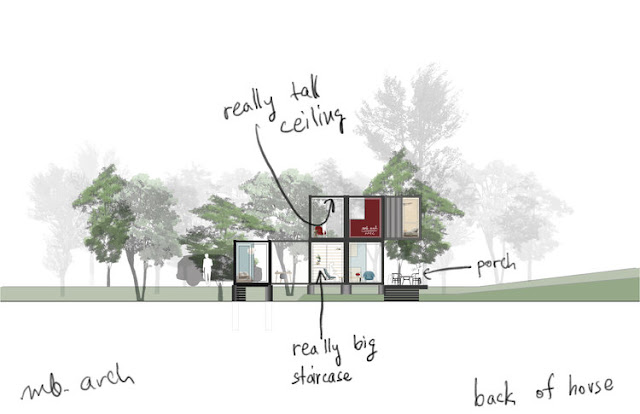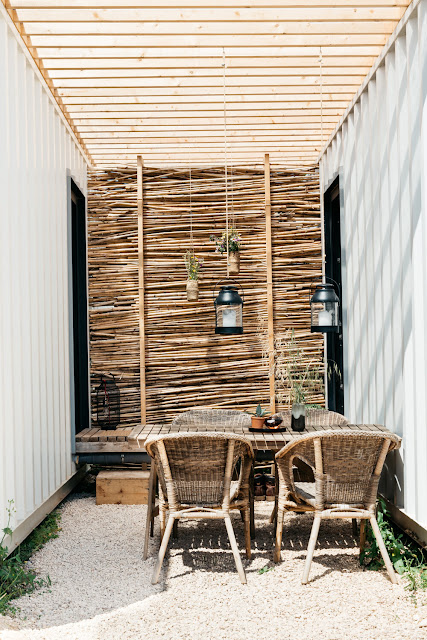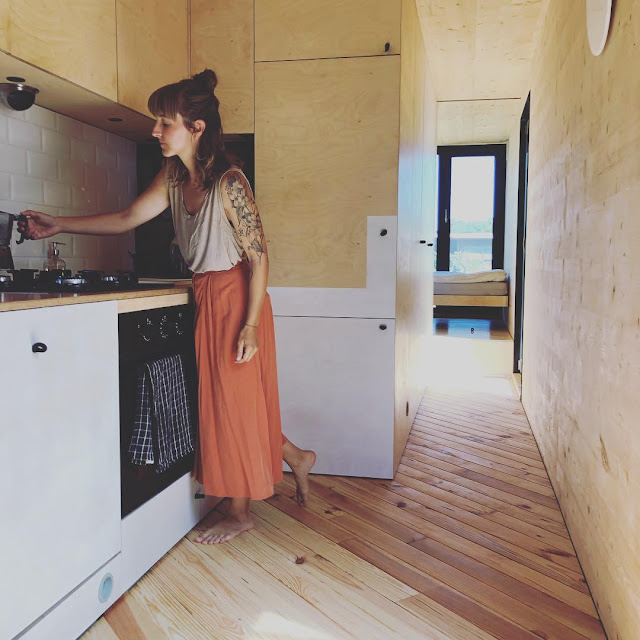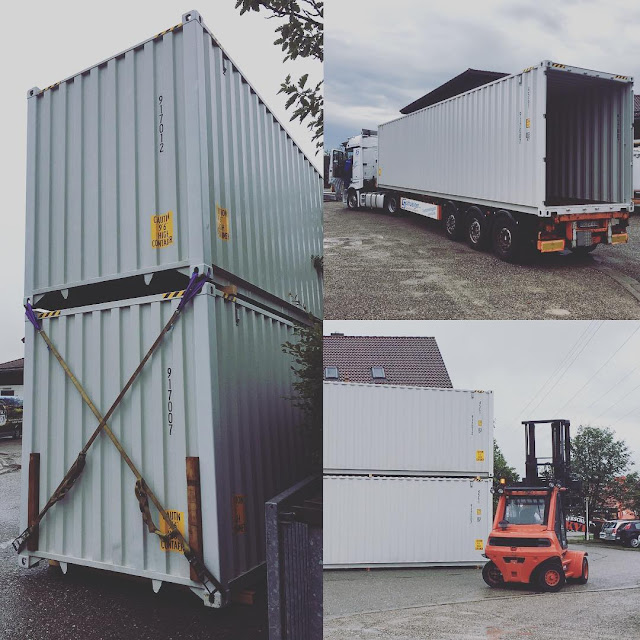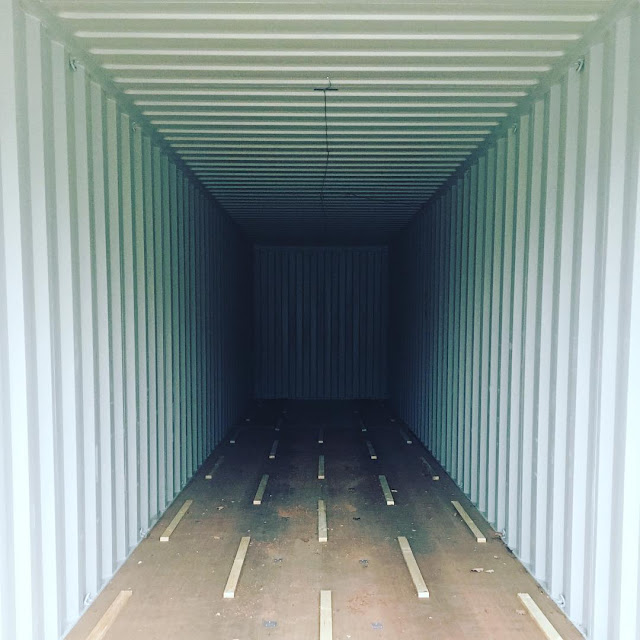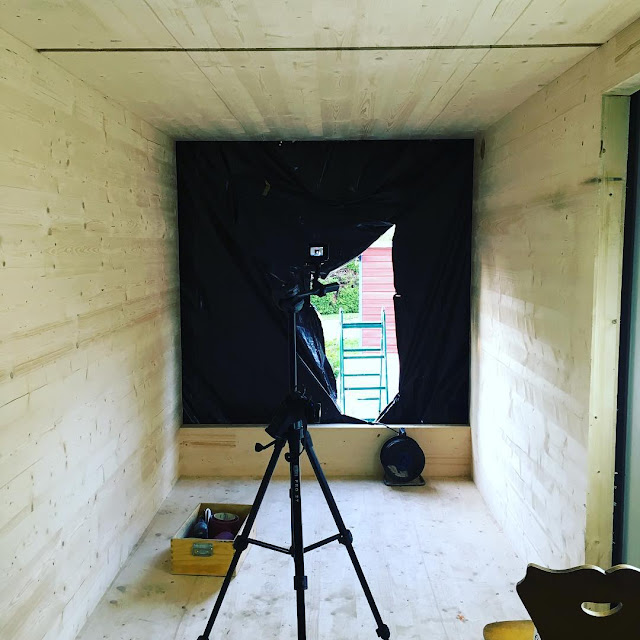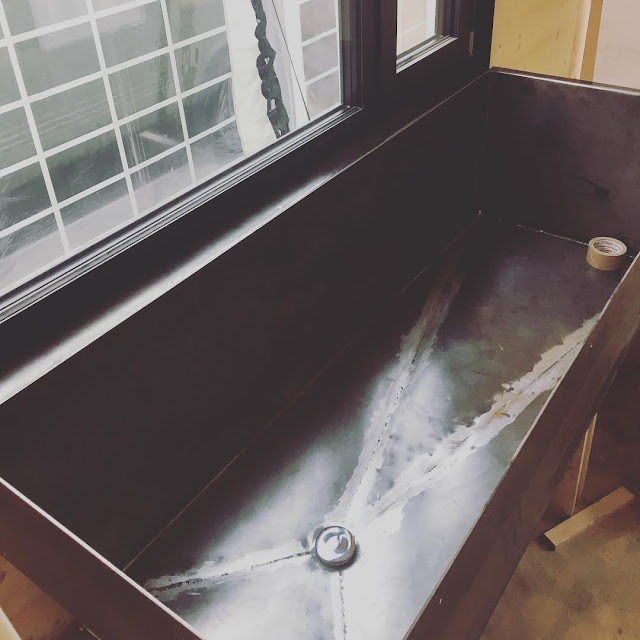This four-bedroom, 1800 sf, shipping container modular house was completed in March 2019. Its a breakthrough project for MB Architecture and they hope it will provide a template for many future homeowners who may want to bypass the typical process of custom-designing and building homes.
| Drawings |
| About MB Architecture |
| About Gallanti Inc |
Project: Amagansett Modular
Architect: MB Architecture
Builder/General Contractor: Gallanti Inc
Structural Engineer: Keith Ewing
Containers: 6
Area: 1800 sf
Location: Amagansett, Long Island, New York
Year: 2019
Wrapped around a mature oak tree, a light-filled 4 bedroom shipping container modular house embraces the outdoors in more ways than one.
In the East Hampton village of Amagansett, Manhattan-based MB Architecture has completed their largest—and most complex—prefab project to date: a 1,800-square-foot shipping container home that emphasizes indoor/outdoor living.
"It’s the culmination of 10 years of research prototyping," says Maziar Behrooz, founder of MB Architecture. His award-winning cargotecture work drew the attention of the clients, a couple with three young children, who had been looking for an alternative to the ubiquitous wood-shingled homes in the Amagansett area.
"The fact that our prefab projects are less expensive and take less time to build was an additional incentive," adds Behrooz.
The home, dubbed the Amagansett Modular House, is modeled after MB Architecture’s insta_house — a scalable, prefab structure made of four 40-foot-long shipping containers that can be stacked together and installed in just one day.
To meet the clients’ requirements for a four-bedroom, three-bath retreat, the architects expanded upon the insta_house blueprint with an additional 40-foot container on the north side—connected to the main double-height volume via a glassed-in walkway—as well as a 10-foot container that hangs off the second floor.
These modifications also respond to the sloping site, which informed the placement and orientation of the west-facing building. The external corrugated metal walls were painted black to help the building recede into the landscape, while multiple floor-to-ceiling windows and glazed doors create seamless connections between the interiors and the outdoors.
"We wanted to create a comfortable, playful, and fun interior for both kids and parents," explains Behrooz of the open layout and dramatic, geometric facade. "And to illustrate how a small house may feel very spacious."
The containers were prefabricated off site before being trucked to the site and installed in two days. The kitchen cabinets, bathroom tiles and fixtures, glassed-in walkway, landscape elements, and pool were added in the weeks after installation.
The speed and efficiency of construction also helped reduce costs, which, excluding the landscape elements and pool, were "in the low to mid $300s per square foot," says Behrooz. "While this is a very high number in, say, upstate New York, it’s significantly lower than average for its location on the east end of Long Island, where construction can cost $500 to $800 per square foot. Our cost of construction is region dependent."
Perhaps the most surprising aspect of the project was how infrequently Behrooz met face-to-face with the clients. The busy couple chose to meet the architects a handful of times, and only twice on site—once when they first purchased the land, and the second time when the house was nearly complete. This arrangement that was somewhat unusual for the practice, which is accustomed to recurrent client meetings.
"So, we were a little worried about how they would feel when coming, with their children, to see the finished house for the first time," says Behrooz. "Their reaction was super joyous, and each kid just ran into a room and found their space. Later that day, we received an email from them saying that the house ‘felt like a temple.’"
The architects applied BM marine-grade paint to the containers’ corrugated metal walls. The home is deliberately compact to match the scale of the neighborhood homes
"The structural design of the 10' pop-out on the second floor is unique. There are no beams under it—it looks afloat," explains Behrooz, who notes that the pop-out was originally cut down from a 20-foot container. "Technically it is not a cantilever—but it is structured from the top (roof) and held back in tension, down to the foundation on the opposite side. It’s kind of a structural breakthrough—we used the inherent structural strength of the containers to our advantage."
The architecture follows the natural contours of the wedge-shaped site: the building is placed on higher ground on the site’s wider east end, while exterior decking steps down to the pool to the west.
The separated bedroom wing includes one shared bathroom. Large windows and glazed doors fitted into either end of the container create an indoor/outdoor living environment.
Taking advantage of the double-height space, the architects created a wall of windows to flood the living area with natural light and frame west-facing views. "At sunset, rays of light literally go all the way through the house," note the architects.
The sun-soaked living area is furnished with a vintage reed mat made by the Tuareg tribe of North Africa (purchased at a flea market), a Toga sofa from Ligne Roset, and a Saarinen table with Tolix red stools.
A 20-foot container cut down to half its length was attached to the second floor to house the master suite.
Large windows in the upstairs bedrooms create the illusion of being immersed in the treetops. The custom furniture is by Santiago Campomar.
The minimalist kitchen is outfitted with Corian countertops. The floors throughout are bleached oak.
Two signature features of MB Architecture–designed prefabs are a double-height space and a wide staircase. "We love the wide staircase—it becomes a place to sit, and watch sunsets," says Behrooz.
Drawings
About MB Architecture
We are a multi-disciplinary, award winning studio of design, architecture, & planning with offices in the Chelsea area of Manhattan & in East Hampton. Our East Hampton office was established in 1996.
Over the past 30 years, we have helped envision, design and build a diverse range of structures and spaces from affordable pre-fabricated micro-homes to private residences, we've built installations, commercial and cultural spaces at the overlap of technology and art, places of worship, affordable multi-unit housing, specialty museums and public spaces.
Our built work is dotted in numerous locations on the East End of Long Island (Hamptons), in New York, and Germany; and we have envisioned projects for New Orleans, China, Austria, Kenya, Papua New Guinea, and Chile.
Working on the East End of Long Island between the Long Island Sound and the Atlantic Ocean, amongst estuaries, wetlands, and farmland, and above two aquifers from which we pump our drinking water, as well as in the highly dense environment of New York City, gives us a critical opportunity and challenge to carefully observe the relationship between human settlement and nature, and the long-term impact of buildings on the environment. The study of localized patterns of living, human interaction with buildings and nature, material exploration, the understanding of localized construction processes, limitations, and techniques, and an appreciation of the common, visible but unseen aspects of architecture all guide us in our research.
Whether working in the city or in rural areas, our work is informed by the contrasting interdependence of Nature and City; making the built (or the building) in our work a mere component, albeit a vital one, of a total environment.
Maziar Behrooz
Maziar is a graduate of Tulane, and Cornell Schools of Architecture and the Institute for Architecture and Urban Studies.
He is an Advisory Board Member at the Tulane School of Architecture, a guest curator at the Parrish Museum of Art, and a member of the AIA Peconic where he served as a past president.
Maziar's work has been exhibited at the Salomon Contemporary Gallery, the Parrish Museum of Art Road Show, the Outsider Art Fair, and the Australian National Maritime Museum.
A Note on Sustainability
Working on the East End of Long Island between the Long Island Sound and the Atlantic Ocean, amongst estuaries, wetlands, and farmland, and above two aquifers from which we pump our drinking water, gives us a critical opportunity and challenge to carefully observe the relationship between human settlement and nature, and the long-term impact of buildings on the environment. More recently, with the opening of our satellite office in the heart of New York City, the highest density large city in the country, we closely observe the distinctions of high-density living in multifamily high-rises and low-density living in single family homes. We experience first hand the real and measurable effect of buildings on our drinking water, wetlands, natural barriers, plant life, and air quality and the critical importance of making real improvements. We strive to tread our grounds with care while recognizing the inherent challenge of building sustainably in an area dominated by single family residences.
We don't just design buildings; we create integrated environments. In fact, the built (or the building) in our work, in particular in our recent design projects, is a mere component, albeit a vital one, of a total environment. In the case of our short-listed proposal for a 600 person Baha'i Temple at the foot of the Andes, for example, the experience of the complete cycle of nature and nature-based uses led to an architectural design that relies on the geological features of the site for its spatial definition and completion. This fundamental shift in attitude, a reversal of the conventional relationship between buildings and nature whereby buildings are a component of much larger Architecture of the Environment, characterizes our approach to design.
In 2008, we built the first green-roof in Montauk. This minimized storm water runoff, added additional insulation, and made the roof an inviting and livable space. For our next project, the Arc House, we went beyond planting sedum on the roof and buried much of the structure within the landscape. This took advantage of the naturally temperate ground temperature and substantially decreased the house’s energy consumption. In addition to the naturally regulated subterranean part of the house, the rounded shape of the above-ground portion of the structure created a natural convection in the space and stabilized the temperature of the room. Most recently, for the the Sayres House and Hanging Gardens, we created multiple landscaped terraces adding more green-space to the property than we removed by building the structure. As architects, our specific role is to demonstrate alternative methods of planning and construction that promote our total ecological philosophy while helping preserve, sustain and regenerate the environment.
As practitioners, our challenge is to apply this attitude to every project, large or small, affordable or luxurious. While the physical results vary, we consistently aim for the maximization, wherever possible, of contiguous natural habitats. By clustering buildings and increasing managed landscapes, we leave nature to perform its self-healing, self-cleaning processes. We like to explore site layouts that reduce or otherwise draw attention to the impact of buildings on the environment. In our proposal for 90 units of affordable housing in Norwalk, Connecticut, for example, alternative building technologies are integrated with a site plan that reverses suburban and wasteful development while creating a model for the regeneration of a neighborhood. The use of passive systems which take advantage of solar orientation, wind direction, and landscaping are fundamental to our decision making process while the examination of efficient and alternative materials and building technologies is a fulfillment of that promise.
Chelsea, Manhattan, New York, NY | ||
| Address | 529 W 20th St #6w, New York, NY 10011, United States | |
| Phone | +1 631-329-2983 | |
| info@mbarchitecture.com | ||
| Website | https://www.mbarchitecture.com/ | |
East Hampton | ||
| Address | 7 Newtown Lane, East Hampton, NY 11937, USA | |
About Gallanti Inc
| Address | 83 Wainscott NW Road, Wainscott, NY 11975, United States | |
| info@cgallantiinc.com | ||
| Website | https://www.charlesgallantiinc.com/ |
Links
Dwell https://www.dwell.com/article/amagansett-modular-house-mb-architecture-a9a04e07
More shipping container homes in New York:
Bard Media Lab Shipping Container Classroom, New York
Carroll House - 5000 sq ft Shipping Container Home, Brooklyn, NYC, USA
Shipping Container Homes by Steele House and Bigprototype, New York
2000 sq ft Modular Shipping Container Home, East Hampton, New York
Shipping Container Art Studio, Long Island, New York
4 Bedroom Shipping Container Modular House, New York
















